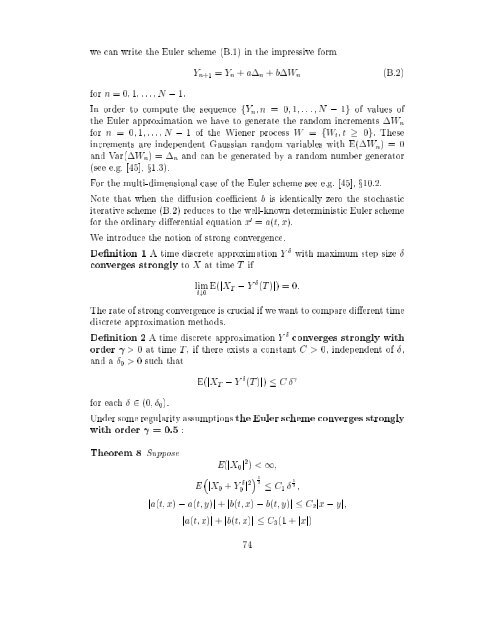Estimation in Financial Models - RiskLab
Estimation in Financial Models - RiskLab
Estimation in Financial Models - RiskLab
Create successful ePaper yourself
Turn your PDF publications into a flip-book with our unique Google optimized e-Paper software.
we can write the Euler scheme (B.1) <strong>in</strong> the impressive form<br />
Y n+1 = Y n + a n + bW n<br />
(B.2)<br />
for n =0; 1;:::;N , 1.<br />
In order to compute the sequence fY n ;n = 0; 1;:::;N , 1g of values of<br />
the Euler approximation we have to generate the random <strong>in</strong>crements W n<br />
for n = 0; 1;:::;N , 1 of the Wiener process W = fW t ;t 0g. These<br />
<strong>in</strong>crements are <strong>in</strong>dependent Gaussian random variables with E(W n ) = 0<br />
and Var(W n )= n and can be generated by a random number generator<br />
(see e.g. [45], x1.3).<br />
For the multi-dimensional case of the Euler scheme see e.g. [45], x10.2.<br />
Note that when the diusion coecient b is identically zero the stochastic<br />
iterative scheme (B.2) reduces to the well-known determ<strong>in</strong>istic Euler scheme<br />
for the ord<strong>in</strong>ary dierential equation x 0 = a(t; x).<br />
We <strong>in</strong>troduce the notion of strong convergence.<br />
Denition 1 A time discrete approximation Y with maximum step size <br />
converges strongly to X at time T if<br />
lim E(jX T , Y (T )j) =0:<br />
#0<br />
The rate of strong convergence is crucial if we want to compare dierent time<br />
discrete approximation methods.<br />
Denition 2 A time discrete approximation Y converges strongly with<br />
order > 0 at time T , if there exists a constant C > 0, <strong>in</strong>dependent of ,<br />
and a 0 > 0 such that<br />
for each 2 (0; 0 ).<br />
E(jX T , Y (T )j) C <br />
Under some regularity assumptions the Euler scheme converges strongly<br />
with order =0:5 :<br />
Theorem 8 Suppose<br />
E(jX 0 j 2 ) < 1;<br />
E jX 0 + Y <br />
0<br />
j 2 1 2<br />
C 1 1 2 ;<br />
ja(t; x) , a(t; y)j + jb(t; x) , b(t; y)j C 2 jx , yj;<br />
ja(t; x)j + jb(t; x)j C 3 (1 + jxj)<br />
74
















